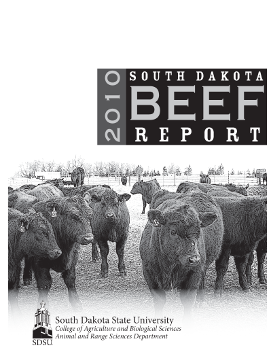Document Type
Report
Report Number
2010-15
Publication Date
2010
Summary
Inclusion of alfalfa (Medicago sativa L.) in grasslands has long been valued to increase forage production and quality. Persistence of alfalfa in semiarid rangeland has generally been poor when non‐adapted and/or conventional hay‐type cultivars are utilized, however. Demand exists for alfalfa cultivars that establish readily and persist, particularly under grazing, in semiarid rangelands. A wild population of predominantly yellow‐flowered alfalfa (Medicago sativa subsp. falcata) was found growing and reproducing naturally in the Grand River National Grassland in northwestern South Dakota. This predominantly falcata alfalfa therefore demonstrates persistence in this semiarid environment. We initiated a study in May 2006 at the SDSU Antelope Livestock & Range Field Station near Buffalo, SD to evaluate persistence and vigor of eleven alfalfa populations transplanted into mixed‐grass prairie. Populations consisted of four predominantly falcata experimental populations (three are naturally selected and locally adapted; one is artificially selected), one pure falcata experimental population, one pure falcata cultivar, two pasture‐type cultivars, and three conventional hay‐type cultivars. Greenhouse grown seedlings were transplanted on 1 m‐centers within three exclosures (35 m X 35 m) divided into two sections; one exposed to grazing, the other protected from grazing. Grazing by cattle was initiated in August 2007. During the 2008 and 2009 growing seasons, intense grazing of alfalfa plants and associated vegetation occurred monthly for 1‐2 days. Survival, height, and canopy volume of grazed and protected alfalfa plants were measured before each grazing event. Despite a harsh winter with persistent ice cover, data from May 2009 revealed that falcata‐based populations had the highest survival under grazing (mean survival = 36%). Pasture‐type cultivars and conventional hay‐type cultivars experienced substantial mortality losses under grazing (mean survival = 8%). Low mortality and high vigor of all protected plant populations indicates that grazing weakened the grazed plants, greatly increasing the risk of winterkill and winter injury. These findings reveal that environmental adaptation, in addition to a degree of grazing tolerance, is necessary for persistence under grazing in this semiarid region. Populations that exhibit high persistence under both grazing and severe winter conditions offer great potential for being utilized in the northern Great Plains.
Number of Pages
10
Format
application/pdf
Language
en
Publisher
South Dakota State University
Rights
Copyright © 2010 South Dakota State University.
Recommended Citation
Misar, C.G.; Xu, L.; Gates, R.N.; Boe, A.A.; and Johnson, P.S., "Persistence of Various Alfalfa Populations in South Dakota Rangeland" (2010). South Dakota Beef Report, 2010. 16.
https://openprairie.sdstate.edu/sd_beefreport_2010/16


